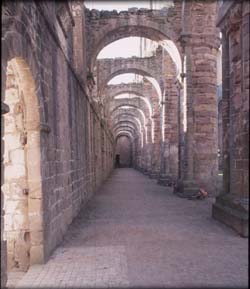 |
 |
 |
 |
 |
 |
 |
|
Fountains Abbey: History
Fountains Abbey: Buildings
|
The layout of the church (continued) (5/13) The increased number of monk priests within the community in the later Middle Ages, and a growing demand for their prayers and masses, meant that more altars and chapels were now required for private prayer. As the aisles were no longer needed for access, they were now screened off from the main body of the church and nine chantries were inserted - five of these were in the south aisle and four in the north aisle.(13) Changes in the internal organisation of space, therefore, reflected primarily changes in the community’s needs, but they were also affected by legislative developments within the Order. For example, new rulings regarding burial within the Cistercian precinct meant that from the late thirteenth century this was permitted within the abbey churches, and not restricted to the galilee, chapter-house, cloister or cemetery. This concession was first granted to patrons and later to abbots.(14) The earliest known lay burial within the church at Fountains is that of the great nobleman, Roger de Mowbray, who was buried in the presbytery in 1298.(15) In 1315, Henry de Percy, lord of Alnwick, was buried in a choice location, for his tombstone was set before the High Altar. The cover to his tomb still survives, and shows him in knightly garb, complete with chain-mail. |
